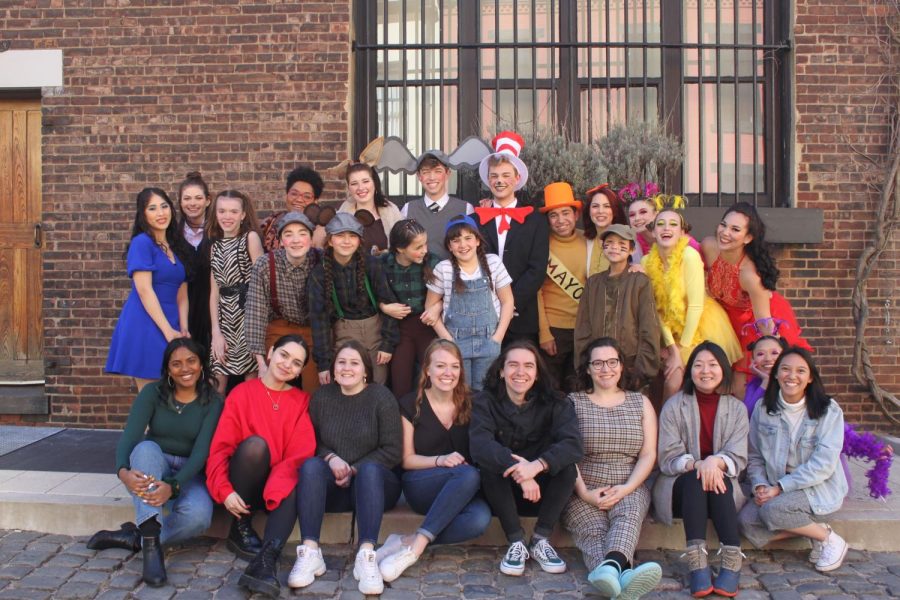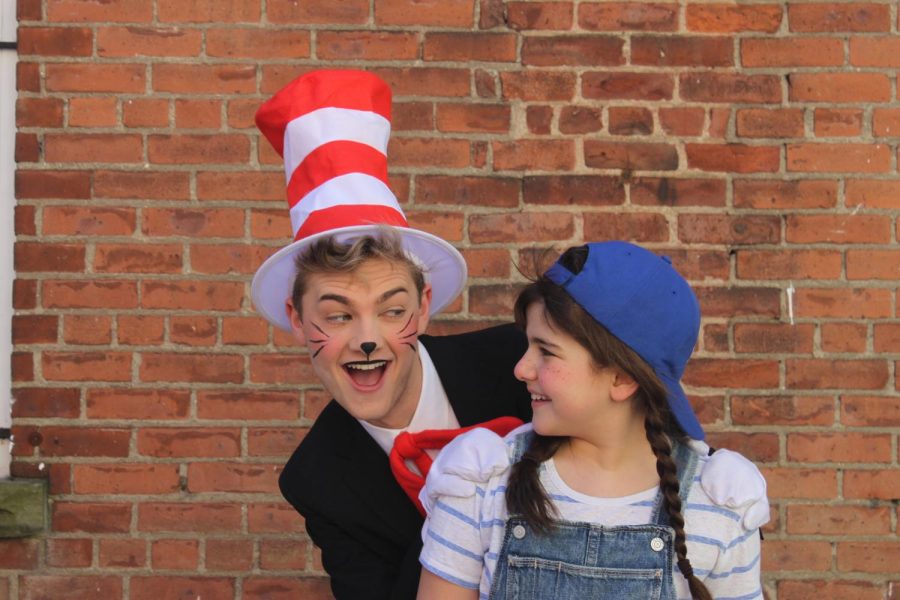
When picking the show for Lamplighters this spring, director and Steinhardt first-year Alex Oleksy said they chose “Seussical” because it was “Seussey.” In other words, it was an easy way to create a fantastic show while staying within a college theater group budget.
“We realized that it works really well as a club show because you’re able to take these everyday items or these like these minimalistic materials that you may have and you’re able to create a full show out of it,” Oleksy said.
Lamplighters is an all-university club that focuses on bringing theater to children. In that same spirit, they started an initiative last year called the Youth Musical Theater Collective, (YMTC), which invites child actors from across the city to audition and work with NYU students on a fully mounted production.
Before the whole pandemic became a thought in anyone’s minds, Lamplighters was planning their vision for “Seussical.” The musical is an almost fully sung-through piece that incorporates many of Dr. Seuss’s classic tales into its narrative, focusing mainly on “Horton Hears a Who!” It features many of the beloved characters from the Seuss-lore, including the iconic Cat in the Hat.
The production was in the midst of preparing for tech week when it was shuttered due to the ongoing pandemic but the production team had had COVID-19 on their radar already because of parental concerns earlier on. Even so, it wasn’t until March 9 when NYU sent an email stating that classes would be going online with hopes of returning to in-person instruction by March 27 that the production team began to worry.
“It was like a shockwave through the entire creative team,” Olesky said. “I was on the phone all day saying okay here’s what we’re going to do. Are we still gonna have rooms available? Are we still going to be able to rehearse? Like what does this mean for us?”
Instead of having NYU students audition, YMTC reaches out to people across campus that they think would make good mentors and performers in the show. They look at people who have previously worked with the club as well as people who have worked in positions which involve interacting with kids, such as camp counselors.
“We wanted to make sure that these are people that can not only serve as actors, but can also serve as teaching artists to these younger kids,” Oleksy said.
Since YMTC is a program that features child actors, Oleksy found that his main goal at the start of rehearsals on February 4 was getting those cast members to feel comfortable with the new space they would be working in. To achieve his aim, at the very first rehearsal Oleksy paired each kid up with an NYU student in the show who would mentor them throughout. Oleksy chose the pairings based on who the kids would be working with most throughout the show.
At the second rehearsal, the focus shifted to getting everyone, young and student performers alike, to be on the same playing field. Oleksy decided they would not look at the script at all in these early rehearsals, instead putting an emphasis on getting in tune with each other and the world of theater around them.
“We wanted to make sure that we’re not all just comfortable with each other, but we’re comfortable with the lingo of the show,” Oleksy said. “What does upstage mean or downstage right or stage left. What does focus mean?”
When directing Oleksy takes a different approach by working with the actors in a collaborative way instead of just giving prescriptive notes and telling them what he wants them to be doing in each scene.
“I like to call it student-focused or student-centered practice,” Oleksy said. “If there’s a piece of blocking that just isn’t working right, I always like to ask my cast and say, ‘well, what feels right to you?’”
Since “Seussical” itself is a very big undertaking, Oleksy felt as though it was nice to have more fluid communication to make the show more manageable. This way of directing through joint-cooperation comes from a motto Oleksy holds himself to whenever directing.
“What my motto as a director is I am not a genius,” Oleksy said. “At the end of the day you’re working with so many different creative minds that you’re doing yourself a disservice by not working with those same creative minds.”
By the time the rights to the show were acquired, the budget went down to $800. Trying to mitigate this, the production team decided to prioritize which costumes and props had to be splurged on and which they could make for much less. The team put the spirit of imagination that Dr. Seuss inspires to good use in their inventive set design.
“We took these 200 boxes and we just painted them different, vibrant colors,” Oleksy said. The boxes were used as an interactive backdrop for the actors, as throughout the show they would take pieces down to use as varying settings.
When working on creating the world of Seuss, the costume team worked to find innovative ways to make the characters come to life. They searched through costume shops to find things and took to creating original pieces unique to their vision. The most difficult prop to make, according to CAS first-year and the co-costume designer Jojo Yang, was creating different characters’ ears.
“Horton’s ears were huge and we wanted to sew them into these hats and it was really tough,” Yang said. “They weren’t standing up straight and we weren’t sure how we were supposed to sew them into the hat in a way that they weren’t just flopping around immediately.”
These costumes are currently in limbo, but once they are all collected, Lamplighters plans to put them in their personal prop and costume stock, donate or rent them out to other theatre companies across the country.
Before it abruptly came to a halt, the production went at full steam. The NYU actors found themselves not only mentoring the kids but also learning from them. One NYU actor, Ben Raanan, who was set to play the Cat in the Hat, was impressed by the level of professionalism and knowledge the young performers readily brought to the table.
“It was really interesting just to see how experienced these kids are and how much they already know,” Raanan said. “You know, there’s this little, small child talking about becoming an Alvin Ailey dancer.”

One of his favorite moments from working on “Seussical” was Park Day at the start of March. Throughout the day the cast went to Washington Square Park to take promotional pictures for the show. They talked to kids and their parents alike, informing them of the upcoming show and the program they were all a part of. Unknowingly, this was the first and the last time the entire cast gathered in full costume.
“I did a reading of ‘The Lorax’ to a group of kids in the little playground area of Washington Square Park,” Raanan said. “All of them were a little skeptical because I didn’t look like the Cat in the Hat that they had seen on TV, but I told them the camera adds 10 pounds.”
“Seussical” tickets went on sale on Dr. Theodor Seuss Geisel’s birthday, March 2, otherwise known as Seuss Day. Within 10 hours the tickets for all three shows sold out and the opening day was set for March 28.
At their last rehearsal, the production team told the cast that they would be postponing the show indefinitely due to the online classes’ notice, not knowing that less than a week later the semester would become permanently remote leading to a full cancellation. That last rehearsal also happened to be the cast’s first full run-through of the show, which excited the young performers as they had been rehearsing for weeks.
“It was such a hard conversation to have with these kids because they were really getting to feel they were accomplishing what their goal was, and then we had to take it away from them the second that it happened,” Oleksy said.
Seth Mabry, a first-year at Steinhardt, was supposed to play Horton the elephant from the classic “Horton Hears A Who!” While sad the show came to an abrupt end, he chose to try and focus on the positives, remembering the good times of working on the production.
“Something that I’ve been having to like actively tell myself is that just because you didn’t have a performance doesn’t mean a production didn’t happen,” Mabry said. “Just because we didn’t get to perform for a huge audience on a stage doesn’t mean that I haven’t learned something.”
Despite the closure, Oleksy has organized two post-production meetings with the cast and crew from NYU to check in on everyone and how they were doing as well as reflect on the production.
For many whose shows and events were canceled, they are trying to make the best out of what they lost. Some even feel the need to emulate William Shakespeare, who in 1606, while quarantined during a plague outbreak, wrote “King Lear,” and “Antony and Cleopatra.” But Oleksy had a few words to say to them.
“It is okay to not write your ‘King Lear.’ It is okay to just take care of yourselves, and whenever everything is back to normal, that’s when we can put our creativity into motion,” Oleksy said. “Take care of yourself first and then come back and remember why you love this art, why you love creating art.”
Email Kaylee DeFreitas at [email protected]. Read more from Washington Square News’ Spring 2020 Arts Issue.






















































































































































